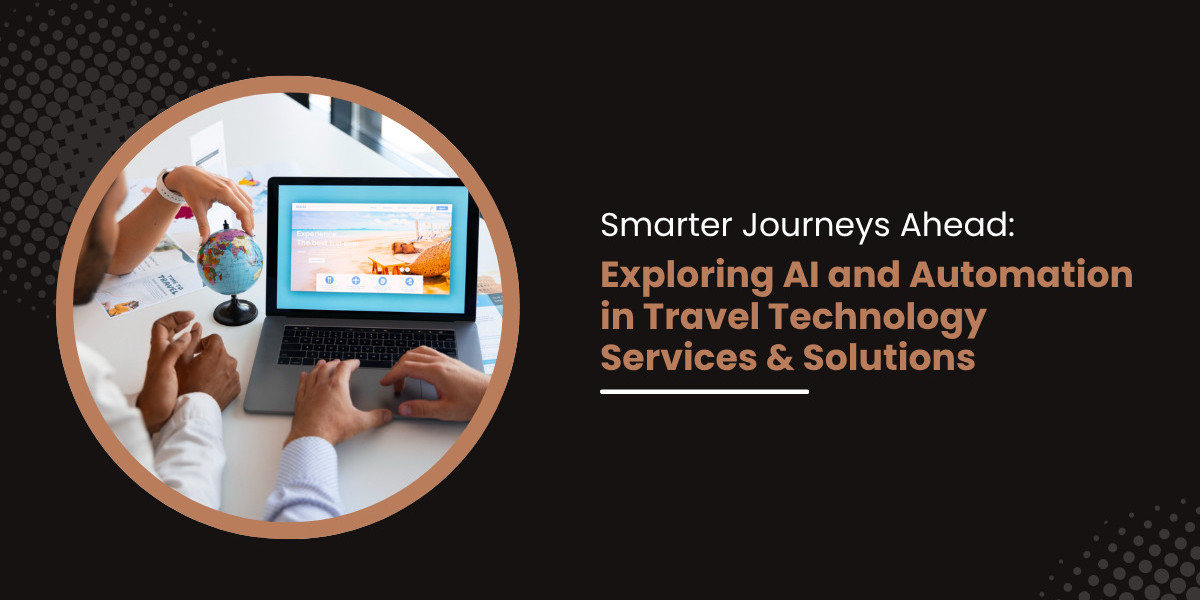In 2024, 68% of travelers indicated they used AI for trip bookings, while 55% anticipated quick responses during their travels. Travel agencies that implemented automation experienced a 30% reduction in support waiting times and a 20% increase in customer satisfaction. A provider of Travel Technology Services & Solutions combines technical challenges with client requirements by utilizing AI models, automation, real-time analytics, and chatbots. This article explores the essential structure, technological approaches, practical systems, and obstacles associated with promoting intelligent travel experiences
System Architecture for Scalable Travel Platforms
Travel platforms need to manage countless requests, regular pricing changes, and intricate transactions. Providers frequently opt for a microservices architecture. Every domain's flight search, hotel availability, and customer service are hosted separately. These services operate in containers overseen by Kubernetes or serverless platforms such as AWS Lambda. This configuration guarantees robustness, automatic scaling, and segmented development.
Components that provide support consist of:
A real-time event streaming data pipeline (Kafka, Kinesis)
A feature repository (such as Feast) to assist machine learning models.
A data warehouse (BigQuery, Snowflake) for analytics reporting.
A time-series database (InfluxDB, TimescaleDB) for system metrics.
This modular framework enables AI and automation tools to connect and grow independently.
Semantic Search: Understanding Traveler Language
Conventional search aligns solely with keywords. Semantic search utilizes natural language processing to grasp the intentions of travelers. Transformer-based models (BERT, Reformer) interpret queries such as “family beach vacation in July under $1500” and identify intent, budget, weather preferences, and date ranges.
These models translate queries and inventory into vector embeddings. Employing a tool such as Faiss for similarity searches, systems deliver the best matching results in less than 150 ms. Semantic relevance enhances booking conversions by 15% in the majority of AI-powered implementations.
From Data to Smart Recommendations
Recommender systems integrate collaborative filtering with content-based techniques. Providers create embeddings for users and items. They gather user preferences, previous reservations, demographic indicators, and metadata like destination type or facilities. A hybrid model combines deep neural networks with gradient-boosted decision trees. This configuration provides tailored recommendations for "popular wellness retreats for families." A/B tests usually show a 12% rise in enhancing travel package sales. These suggestions refresh every night by utilizing streaming preferences and seasonal patterns.
Conversational Agents for 24/7 Support
Contemporary chatbots utilize frameworks such as Rasa, Dialog Flow, or specialized transformer architectures. These agents combine NLU (Natural Language Understanding), dialogue management, and backend integrations. A traveler could send a message saying, “Alter my June flight to New York.” The chatbot interprets intent and entities, subsequently invoking microservices (through gRPC or REST) to retrieve booking information, verify policy limitations, and suggest alternative flights.
Bots maintain session state in either memory or Redis. This stops travelers from reiterating details. As much as 70% of support inquiries, such as cancellations, rebookings, or booking confirmations, can be completely managed by bots. Support response times decrease from hours to less than five seconds.
Dynamic Pricing and Yield Management
The prices of tickets, hotel accommodations, and additional revenue vary according to demand, competitor rates, and available inventory. Providers assimilate real-time datasets on inventory levels, competitor pricing, booking rates, historical trends, and utilize pricing models based on gradient boosting or reinforcement learning.
Through the distribution of different offers to user groups, systems understand price elasticity. A trial run indicated a 6% increase in revenue and improved occupancy levels. These pricing choices depend on a scalable feature pipeline and a model retraining schedule that operates daily.
Automated Itinerary Management
Travelers frequently arrange multi-stop journeys that include flights, trains, and accommodations. AI systems must integrate these into structured itineraries. They utilize timetables, minimum connection durations, passport visa regulations, and individual choices. A solver (e.g., using ILP or heuristic methods) produces optimized multi-stop journeys, refreshing nightly.
When disruptions happen such as delays, cancellations, or missed connections, the system activates rebooking procedures. Travelers receive push notifications automatically and may have itineraries rebooked automatically, based on the conditions of their tickets. This automation lessens the need for manual agents and enhances traveler contentment.
Fraud Detection with Machine Intelligence
Travel platforms encounter risks like fraudulent reservations and payment exploitation. AI models such as random forests and basic DNNs operate in real time during checkout. They analyze factors such as IP location, speed of payment method, device identification, and reservation trends. Transactions exceeding thresholds necessitate either 2FA verification or are directed to manual assessment. Fraud rates decrease by almost 50% following the introduction of automated checks.
Providers also conduct risk assessments on destinations. When the risk of political instability or natural disasters increases, systems mark affected travel plans and recommend rescheduling or refunds prior to travelers reaching out for assistance.
Backend Workflow Automation
Data engineering workflows operate with tools such as Apache Airflow or AWS Step Functions. Reservation data, activity logs, session metrics, and user engagements undergo ETL processes and are stored in analytics repositories. When established, data activates model retraining, updates dashboards, or initiates regulatory reporting.
DevOps employs CI/CD pipelines that include unit and integration tests, as well as canary or blue-green deployment methods. Travel Technology Services & Solutions providers implement infrastructure-as-code to ensure uniform environments among teams.
Real-World Deployment: A 360-Degree Travel Platform
A mid-range travel platform collaborated with a Travel Technology Services & Solutions company to enhance revenue and quality of service. Key points from execution:
Implement semantic search for accommodations, air travel, and bundles.
Real-time competitor feeds optimize the dynamic pricing engine.
Chatbot handling 60% of queries
Automation of itineraries for updates and disruptions
Monitoring high-risk transactions in fraud models
In just eight months, the platform experienced an 18% increase in conversions, 8% more revenue per booking, 35% reduction in support tickets, and achieved a satisfaction rating of 4.7 out of 5.
Technical Hurdles and Solutions
Data quality presents a significant issue. Travel datasets often contain inaccuracies, gaps, or are submitted late. Teams establish validation rules to identify irregularities and filter out poor inputs. They label data with precision ratings and create feedback loops connecting support and model development. Latency is very important. Systems utilize caching (Redis, Memcached), reduce vector dimensions for rapid similarity searches, and implement asynchronous workflows to maintain response times below 200 ms.
Compliance with privacy regulations (GDPR, CCPA) introduces additional complexity. Platforms utilize concealed data repositories, log obfuscation, role-specific access controls (RBAC), and encryption when idle. Additionally, they permit users to request the deletion of personal data.
Emerging Trends in Travel Tech
Voice-driven reservation systems are conducting high-level pilot initiatives. These combine speech recognition and natural language understanding processes. Travelers can request, “Reserve a flight for me to Paris next Friday.” The system analyzes it and links to booking APIs.
AR incorporation in travel applications is also expanding. Apps at museums use ARKit or ARCore to superimpose guides. Through computer vision, individuals receive immediate information regarding landmarks. ML-driven predictive delay models analyze weather, flight history, and flight paths. They proactively notify travelers, and the platform can suggest alternatives before airlines inform them.
Metrics for Performance and Security
Providers monitor various KPIs to assess impact:
Search response time (goal below 200 ms)
Rate of conversation deflection (percentage of inquiries managed by bots)
Recommendation engagement rate and additional sale value
Dynamic pricing increases
Accuracy in fraud detection and rates of false positives
Percentage of booking completions by device
These metrics are incorporated into dashboards created using Looker or Power BI. They direct ongoing enhancements throughout systems.
Maintaining Continuous Evolution
Travel platforms need to evolve consistently. Providers conduct quarterly security assessments to identify newly found vulnerabilities in dependencies. They track CVE updates and implement patches quickly. Deployment occurs in stages: first 10%, then 50%, and finally complete rollout, with performance evaluations integrated at every step.
AI models evolve as travel behaviors change over time. The group establishes model surveillance to monitor prediction accuracy. If performance decreases beyond a certain point, a self-operating retraining pipeline activates using fresh data.
Best Practices in Travel Technology Services & Solutions
From a technical perspective, effective systems possess essential characteristics:
Modular microservices featuring strong APIs
Real-time data streams for pricing, reservations, and analytics.
AI systems for searching, pricing, fraud detection, and personalization.
Automated processes for interaction and recuperation.
Elastic architecture via Kubernetes or serverless frameworks
Protected framework adhering to privacy and encryption regulations.
Monitoring performance and tracking errors in production.
Security and quality assurance through auditing and staged deployments.
These design principles guarantee agility, dependability, and credibility on a large scale.
Conclusion
AI and automation in Travel Technology Services & Solutions are essential for providing more intelligent travel experiences. Automation enhances traveler experiences and speeds up responses, covering areas like semantic search, pricing, conversational bots, and itinerary recovery. Both technical depth and operational excellence support these platforms, ranging from data pipelines to deployment methods.
Businesses adopting these solutions experience notable improvements: quicker reservations, lower support expenses, higher income, and improved customer loyalty. Upcoming advancements in voice technology, augmented reality, predictive analytics, and zero-trust security are set to enhance personalization and safety in travel experiences. For travel companies, collaborating with skilled service providers will define the upcoming era of user-focused, smart travel systems.








